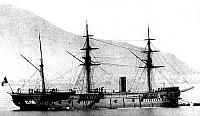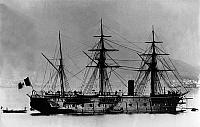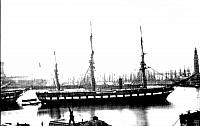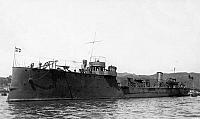Cl. P. DI CARIGNANO
Nel 1860 la Marina Sarda dette l’avvio alla costruzione di quattro pirofregate con scafo in legno la cui capoclasse avrebbe dovuto essere il PRINCIPE UMBERTO. Ma nel 1861 alla proclamazione del Regno d’Italia, nel mentre la prima unità della classe era già in avanzato stato di costruzione nel Cantiere della Foce di Genova (il varo avvenne nell’agosto 1862), si rese necessario riprendere il progetto originario, variarlo e trasformare le altre tre unità “PRINCIPE DI CARIGNANO, MESSINA E CONTE VERDE” in fregate corazzate che, a questo punto formarono, una classe a parte. Con loro realizzazione affidata a cantieri italiani, queste ultime UU.NN. divennero le prime corazzate costruite in Italia.
Essere furono varate:
• PRINCIPE DI CARIGNANO nel Cantiere della Foce di Genova nel settembre 1863;
• MESSINA nel Cantiere di Castellammare di Stabia nel dicembre 1864;
• CONTE VERDE nel Cantiere di S. Rocco di Livorno nel luglio 1867.
Furono tutte dotate di uno sperone e lastre in ferro battuto da 121 mm. di spessore rivestirono le parti emerse degli scafi delle prime due navi e solo la prua e la poppa del CONTE VERDE.
La propulsione era mista ed era affidata sia all’elica che alla vela: albero di trinchetto attrezzato con vele quadre e quelli di maestra e mezzana con vele auriche.
Di circa 76 mt. di lunghezza f.t. vennero immesse in servizio con alcune differenze nel dislocamento a p.c.:
• PRINCIPE DI CARIGNANO oltre 3.900 ton.
• MESSINA oltre 4.200 ton.
• CONTE VERDE oltre 4.300 ton.
Su ogni fiancata, lungo il ponte di batteria, erano disposte le seguenti artiglierie:
• PRINCIPE DI CARIGNANO - n.2 cannoni da 204,5 mm ad anima liscia e n.9 cannoni rigati da 165 mm (n. 8 cerchiati e n.1 non cerchiato).
• MESSINA - n.3 cannoni d'acciaio ad avancarica rigati e cerchiati, (n.1 da 25 cm e n.2 da 20 cm) e n.4 cannoni di ferro rigati e cerchiati ad avancarica da 16 cm.
• CONTE VERDE - n.3 cannoni d'acciaio ad avancarica rigati e cerchiati da 25 cm.
(questa unità era dotata anche n. 1 cannone d'acciaio ad avancarica rigato e cerchiato da 20 cm.)
Solo il PRINCIPE DI CARIGNANO riuscì a prendere parte nel 1866 alla battaglia di Lissa, uscendone indenne mentre le altre due unità della classe furono immesse in servizio successivamente: il MESSINA nel 1867 e il CONTE VERDE nel 1871.
Le tre navi, divennero rapidamente obsolete e tutte radiate nella seconda metà degli anni ’70, a causa del vertiginoso e rapido sviluppo degli studi sulle navi da guerra che misero a disposizione dei progettisti navali materiali, armi, macchine per la propulsione, esplosivi, più performanti. Nacquero, in quegli anni, le nuove navi da guerra con batteria centrale alle quali seguiranno quelle a torretta.
In 1860 the Sardinian Navy started the construction of four wooden-hulled frigates, the leader of which was to be the PRINCIPE UMBERTO. But in 1861 at the proclamation of the Kingdom of Italy, while the first unit of the class was already in an advanced state of construction in the Cantiere della Foce in Genoa (the launch took place in August 1862), it became necessary to resume the original design, vary it and transform the other three units "PRINCIPE DI CARIGNANO, MESSINA and CONTE VERDE" into armoured frigates which, at this point, formed a class of their own. With their construction entrusted to Italian shipyards, these UU.NN. became the first ironclads built in Italy.
These were launched:
• PRINCIPE DI CARIGNANO in the Cantiere della Foce in Genoa in September 1863;
• MESSINA at the Castellammare di Stabia shipyard in December 1864;
• CONTE VERDE in the Cantiere di S. Rocco di Livorno in July 1867.
They were all equipped with a rostrum and 121 mm iron plates that covered the emerged parts of the hulls of the first two ships and only the bow and stern of the CONTE VERDE. The propulsion was mixed and was entrusted to both the propeller and the sail: foremast equipped with square sails and those of mainsail and mizzen with auric sails. About 76 mt. of f.t. length, were put into service with some differences in the displacement f.l.:
• PRINCIPE DI CARIGNANO over 3,900 tons.
• MESSINA over 4,200 tons.
• CONTE VERDE over 4,300 tons.
On each side along the battery deck, were placed the following artillery:
• PRINCIPE DI CARIGNANO – n.2 smoothbore 204.5 mm guns and n.9 165 mm rifled guns (8 rimmed and 1 unrimmed).
• MESSINA - n.3 rifled and rimmed muzzle-loading steel guns, (n.1 of 25 cm and n.2 of 20 cm) and n.4 rifled and rimmed iron guns with muzzle-loading of 16 cm.
• CONTE VERDE - n.3 25 cm rifled and rimmed muzzle-loading steel guns.
(This unit was also equipped with n.1 20 cm rifled and rimmed muzzle-loading steel gun.)
Only the PRINCIPE DI CARIGNANO take part in the Battle of Lissa in 1866, coming out unscathed, while the other two units of the class were put into service later: the MESSINA in 1867 and the CONTE VERDE in 1871.
The three ships quickly became obsolete and all decommissioned in the second half of the '70s, due to the dizzying and rapid development of studies on warships that made more performing materials, weapons, propulsion machines, explosives available to naval designers. In those years, the new warships with a central battery were born, which were followed by those with turrets.
Essere furono varate:
• PRINCIPE DI CARIGNANO nel Cantiere della Foce di Genova nel settembre 1863;
• MESSINA nel Cantiere di Castellammare di Stabia nel dicembre 1864;
• CONTE VERDE nel Cantiere di S. Rocco di Livorno nel luglio 1867.
Furono tutte dotate di uno sperone e lastre in ferro battuto da 121 mm. di spessore rivestirono le parti emerse degli scafi delle prime due navi e solo la prua e la poppa del CONTE VERDE.
La propulsione era mista ed era affidata sia all’elica che alla vela: albero di trinchetto attrezzato con vele quadre e quelli di maestra e mezzana con vele auriche.
Di circa 76 mt. di lunghezza f.t. vennero immesse in servizio con alcune differenze nel dislocamento a p.c.:
• PRINCIPE DI CARIGNANO oltre 3.900 ton.
• MESSINA oltre 4.200 ton.
• CONTE VERDE oltre 4.300 ton.
Su ogni fiancata, lungo il ponte di batteria, erano disposte le seguenti artiglierie:
• PRINCIPE DI CARIGNANO - n.2 cannoni da 204,5 mm ad anima liscia e n.9 cannoni rigati da 165 mm (n. 8 cerchiati e n.1 non cerchiato).
• MESSINA - n.3 cannoni d'acciaio ad avancarica rigati e cerchiati, (n.1 da 25 cm e n.2 da 20 cm) e n.4 cannoni di ferro rigati e cerchiati ad avancarica da 16 cm.
• CONTE VERDE - n.3 cannoni d'acciaio ad avancarica rigati e cerchiati da 25 cm.
(questa unità era dotata anche n. 1 cannone d'acciaio ad avancarica rigato e cerchiato da 20 cm.)
Solo il PRINCIPE DI CARIGNANO riuscì a prendere parte nel 1866 alla battaglia di Lissa, uscendone indenne mentre le altre due unità della classe furono immesse in servizio successivamente: il MESSINA nel 1867 e il CONTE VERDE nel 1871.
Le tre navi, divennero rapidamente obsolete e tutte radiate nella seconda metà degli anni ’70, a causa del vertiginoso e rapido sviluppo degli studi sulle navi da guerra che misero a disposizione dei progettisti navali materiali, armi, macchine per la propulsione, esplosivi, più performanti. Nacquero, in quegli anni, le nuove navi da guerra con batteria centrale alle quali seguiranno quelle a torretta.
In 1860 the Sardinian Navy started the construction of four wooden-hulled frigates, the leader of which was to be the PRINCIPE UMBERTO. But in 1861 at the proclamation of the Kingdom of Italy, while the first unit of the class was already in an advanced state of construction in the Cantiere della Foce in Genoa (the launch took place in August 1862), it became necessary to resume the original design, vary it and transform the other three units "PRINCIPE DI CARIGNANO, MESSINA and CONTE VERDE" into armoured frigates which, at this point, formed a class of their own. With their construction entrusted to Italian shipyards, these UU.NN. became the first ironclads built in Italy.
These were launched:
• PRINCIPE DI CARIGNANO in the Cantiere della Foce in Genoa in September 1863;
• MESSINA at the Castellammare di Stabia shipyard in December 1864;
• CONTE VERDE in the Cantiere di S. Rocco di Livorno in July 1867.
They were all equipped with a rostrum and 121 mm iron plates that covered the emerged parts of the hulls of the first two ships and only the bow and stern of the CONTE VERDE. The propulsion was mixed and was entrusted to both the propeller and the sail: foremast equipped with square sails and those of mainsail and mizzen with auric sails. About 76 mt. of f.t. length, were put into service with some differences in the displacement f.l.:
• PRINCIPE DI CARIGNANO over 3,900 tons.
• MESSINA over 4,200 tons.
• CONTE VERDE over 4,300 tons.
On each side along the battery deck, were placed the following artillery:
• PRINCIPE DI CARIGNANO – n.2 smoothbore 204.5 mm guns and n.9 165 mm rifled guns (8 rimmed and 1 unrimmed).
• MESSINA - n.3 rifled and rimmed muzzle-loading steel guns, (n.1 of 25 cm and n.2 of 20 cm) and n.4 rifled and rimmed iron guns with muzzle-loading of 16 cm.
• CONTE VERDE - n.3 25 cm rifled and rimmed muzzle-loading steel guns.
(This unit was also equipped with n.1 20 cm rifled and rimmed muzzle-loading steel gun.)
Only the PRINCIPE DI CARIGNANO take part in the Battle of Lissa in 1866, coming out unscathed, while the other two units of the class were put into service later: the MESSINA in 1867 and the CONTE VERDE in 1871.
The three ships quickly became obsolete and all decommissioned in the second half of the '70s, due to the dizzying and rapid development of studies on warships that made more performing materials, weapons, propulsion machines, explosives available to naval designers. In those years, the new warships with a central battery were born, which were followed by those with turrets.
-

PRINCIPE DI CAR…
-

MESSINA
-

MESSINA
-

MESSINA
-

CONTE VERDE
-

PRINCIPE UMBERT…
-

PRINCIPE UMBERT…
-

PRINCIPE UMBERT…
-

Cl. P. DI CARIG…
- Primo Precedente
- Foto 1 - 9 di 9
- Prossimo Ultimo
